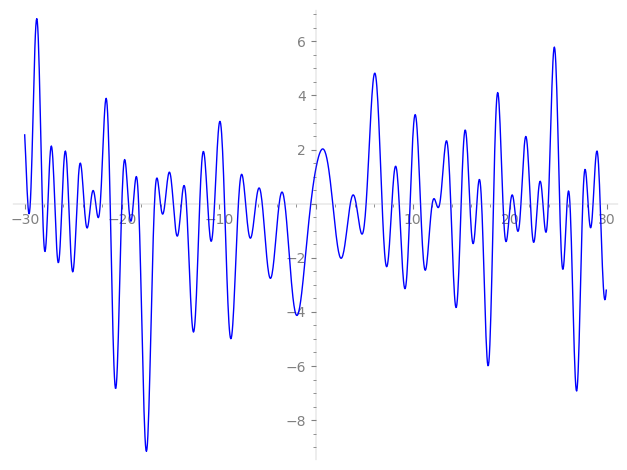| L(s) = 1 | + (1.04 + 1.04i)2-s − 1.79i·4-s + (−5.26 + 5.26i)5-s − 5.54·7-s + (6.08 − 6.08i)8-s − 11.0·10-s − 18.1i·11-s + (7.75 − 7.75i)13-s + (−5.81 − 5.81i)14-s + 5.58·16-s + (18.1 − 18.1i)17-s + (2.37 − 2.37i)19-s + (9.46 + 9.46i)20-s + (19.0 − 19.0i)22-s + (−16.3 + 16.3i)23-s + ⋯ |
| L(s) = 1 | + (0.524 + 0.524i)2-s − 0.449i·4-s + (−1.05 + 1.05i)5-s − 0.791·7-s + (0.760 − 0.760i)8-s − 1.10·10-s − 1.65i·11-s + (0.596 − 0.596i)13-s + (−0.415 − 0.415i)14-s + 0.349·16-s + (1.06 − 1.06i)17-s + (0.125 − 0.125i)19-s + (0.473 + 0.473i)20-s + (0.867 − 0.867i)22-s + (−0.712 + 0.712i)23-s + ⋯ |
\[\begin{aligned}\Lambda(s)=\mathstrut & 333 ^{s/2} \, \Gamma_{\C}(s) \, L(s)\cr =\mathstrut & (0.343 + 0.939i)\, \overline{\Lambda}(3-s) \end{aligned}\]
\[\begin{aligned}\Lambda(s)=\mathstrut & 333 ^{s/2} \, \Gamma_{\C}(s+1) \, L(s)\cr =\mathstrut & (0.343 + 0.939i)\, \overline{\Lambda}(1-s) \end{aligned}\]
Particular Values
| \(L(\frac{3}{2})\) |
\(\approx\) |
\(1.03942 - 0.726745i\) |
| \(L(\frac12)\) |
\(\approx\) |
\(1.03942 - 0.726745i\) |
| \(L(2)\) |
|
not available |
| \(L(1)\) |
|
not available |
\(L(s) = \displaystyle \prod_{p} F_p(p^{-s})^{-1} \)
| $p$ | $F_p(T)$ |
|---|
| bad | 3 | \( 1 \) |
| 37 | \( 1 + (32.1 + 18.3i)T \) |
| good | 2 | \( 1 + (-1.04 - 1.04i)T + 4iT^{2} \) |
| 5 | \( 1 + (5.26 - 5.26i)T - 25iT^{2} \) |
| 7 | \( 1 + 5.54T + 49T^{2} \) |
| 11 | \( 1 + 18.1iT - 121T^{2} \) |
| 13 | \( 1 + (-7.75 + 7.75i)T - 169iT^{2} \) |
| 17 | \( 1 + (-18.1 + 18.1i)T - 289iT^{2} \) |
| 19 | \( 1 + (-2.37 + 2.37i)T - 361iT^{2} \) |
| 23 | \( 1 + (16.3 - 16.3i)T - 529iT^{2} \) |
| 29 | \( 1 + (20.1 + 20.1i)T + 841iT^{2} \) |
| 31 | \( 1 + (10.4 + 10.4i)T + 961iT^{2} \) |
| 41 | \( 1 - 2.51iT - 1.68e3T^{2} \) |
| 43 | \( 1 + (19.0 - 19.0i)T - 1.84e3iT^{2} \) |
| 47 | \( 1 - 33.0T + 2.20e3T^{2} \) |
| 53 | \( 1 - 39.9T + 2.80e3T^{2} \) |
| 59 | \( 1 + (46.2 - 46.2i)T - 3.48e3iT^{2} \) |
| 61 | \( 1 + (-3.22 - 3.22i)T + 3.72e3iT^{2} \) |
| 67 | \( 1 - 44.2iT - 4.48e3T^{2} \) |
| 71 | \( 1 - 92.4T + 5.04e3T^{2} \) |
| 73 | \( 1 + 87.3iT - 5.32e3T^{2} \) |
| 79 | \( 1 + (-39.7 + 39.7i)T - 6.24e3iT^{2} \) |
| 83 | \( 1 - 112.T + 6.88e3T^{2} \) |
| 89 | \( 1 + (113. + 113. i)T + 7.92e3iT^{2} \) |
| 97 | \( 1 + (6.42 - 6.42i)T - 9.40e3iT^{2} \) |
| show more | |
| show less | |
\(L(s) = \displaystyle\prod_p \ \prod_{j=1}^{2} (1 - \alpha_{j,p}\, p^{-s})^{-1}\)
Imaginary part of the first few zeros on the critical line
−11.14086001763290377097263970080, −10.42787694091816033430095840701, −9.398925773306040332526503534447, −7.970061436848926275927815034136, −7.22781338996791177731425170740, −6.17774915323474961210428575032, −5.51538944372251587896743720488, −3.76615615876710832804044143037, −3.18572965152081878266267206764, −0.50978930559692516556876178568,
1.75498169994467340514054991975, 3.56566488635777301397968833428, 4.16318660120702785667917089821, 5.19497252917498137306320479070, 6.84100772644275307990877086833, 7.85004192181215149509645423372, 8.604893466775988460195312196968, 9.722943611019840075621119586865, 10.80149949932809461084847463066, 12.01042412419129496750220051331

